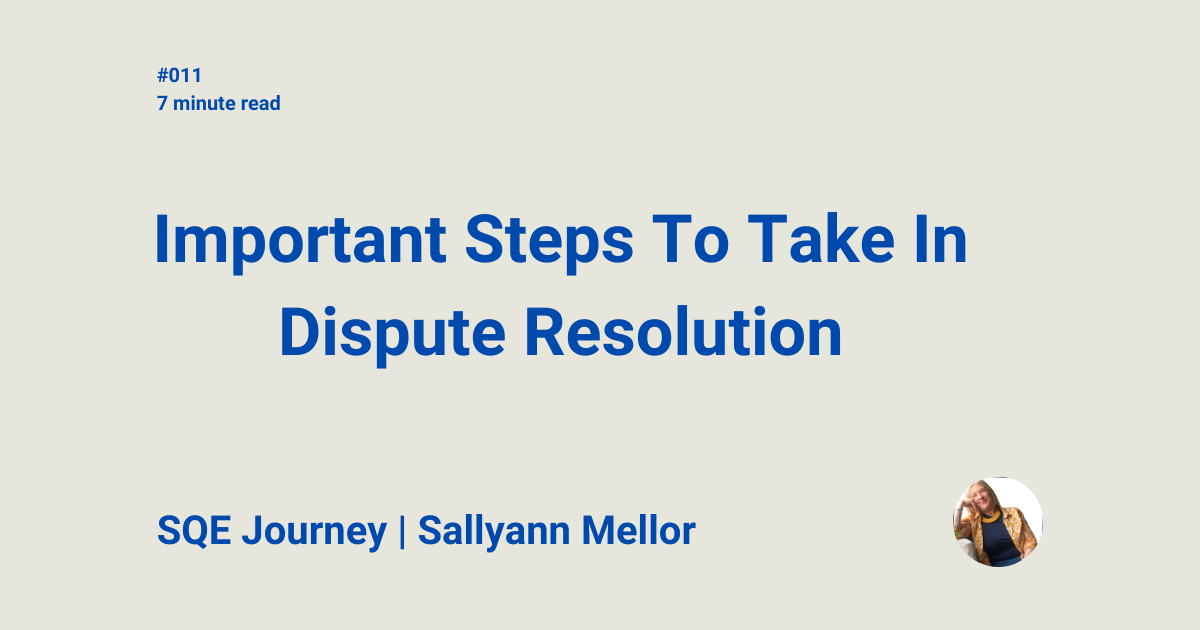important steps to take in dispute resolution
Dispute resolution is an important part of the legal system in the UK, providing mechanisms to resolve conflicts efficiently and fairly. This guide outlines the top ten most important steps to take in dispute resolution cases, aligning with the Civil Procedure Rules (CPR) and other UK legal frameworks. By adhering to these steps, legal professionals can effectively manage cases, uphold transparency and fairness, and achieve the best possible outcomes for their clients.
Some of the SQE candidates I’ve spoken to expressed insights into dispute resolution. I’m excited to bring you the most important steps to take in dispute resolution – a guest post from Sallyann Mellor.

important steps to take in dispute resolution
1. Initial Assessment
Understanding the nature of the dispute and the client’s objectives is crucial. Assess whether the claim meets the legal requirements to bring a claim.
You should consider the following:
1.1. Tort Claim
To bring a tort claim, the following elements must generally be established:
- Duty of Care: The claimant must show that the defendant owed them a duty of care.
- Breach of Duty: The claimant must demonstrate that the defendant breached this duty.
- Causation: The claimant needs to prove that the breach of duty caused their harm or loss. This involves establishing a direct link between the breach and the injury.
- Damage: The claimant must show they suffered actual damage or loss as a consequence of the defendant’s actions. This can be physical injury, financial loss, or emotional distress.
- Limitation Period: The claim must be brought within the statutory time limit. For general tort claims, this is usually six years from the date of the breach, though personal injury claims typically have a three-year limitation period.
1.2. Contract Claim
To bring a contract claim, the following elements must generally be established:
- Existence of a Contract: The claimant must prove that a valid contract existed. This requires offer, acceptance, consideration, and intention to create legal relations.
- Breach of Contract: The claimant must demonstrate that the defendant breached the terms of the contract.
- Causation: The claimant needs to show that the breach of contract caused their loss.
- Loss/Damages: The claimant must demonstrate that they suffered a loss as a result of the breach.
- Limitation Period: The claim must be brought within the statutory time limit. For most contract claims, this period is six years from the date of the breach. In personal injury claims, this period is generally three years from the date of injury.
- Prospects of Success: Evaluate the likelihood of winning the case. This involves analysing the strengths and weaknesses of the case.
- Review proportionality: Will the cost of the claim exceed the potential damages?
- Funding: Discuss funding options with the client, such as conditional fee agreements, legal expense insurance, or self-funding.
2. Gathering evidence
Evidence is fundamental as the burden of proof is on the claimant to demonstrate breach or negligence occurred.
This involves:
- Collecting all relevant documents, example, witness statements, and expert reports.
- Ensuring thorough preparation of evidence to support the claim.
3. Client Communication
Maintaining transparency and regular updates with clients is essential. Always seek client approval before progressing any matter.
- Regularly inform the client about case developments and options.
- Ensure clients understand the legal process and potential outcomes.
- Ensure your advice is client focused in accordance with their individual needs.
4. Negotiation and Pre-action protocols
Engage with the relevant Pre-action protocols under the Civil Procedure Rules (CPR), which encourage early resolution and negotiation.
- Pre-action Protocols: Follow these protocols to share information and resolve issues without litigation.
- Part 36 Offers: Consider these offers as a tactical mechanism to reach a settlement and avoid further costs and court time.
5. Pleadings and Statements of Case
Draft clear and accurate legal documents to narrow the issues in dispute.
- Avoid inaccuracies to prevent serious repercussions, such as court sanctions.
- Clearly outline the legal arguments and supporting evidence.

6. Case Management
The CPR stresses timely preparation and adherence to procedural timelines to ensure efficient case progression.
- Engage in the case management process or face court sanctions.
- Amendments to the timetable can be made with the court’s permission if necessary, however, it is at the discretion of the court.
7. ADR (Alternative Dispute Resolution)
Mediation, arbitration, and other ADR methods are strongly encouraged.
- Consider ADR during the pre-action process and as the case progresses.
- Aim to resolve disputes without resorting to trial.
8. Disclosure/ Discovery
The CPR mandates thorough disclosure of pertinent documents between parties to ensure transparency and fairness.
- Review and disclose all relevant documents to the opposing party.
- Request necessary documents from the opposing party.
9. Preparation for Hearings/ Trials
Comprehensive preparation is vital for presenting a persuasive case according to CPR requirements.
- Prepare witnesses and evidence for presentation in court.
- Develop a clear and persuasive case strategy.
10. post-decision Actions
Implementing court decisions, advising clients on further actions, and ensuring compliance are key post-resolution steps.
- Ensure the court’s decision is executed.
- Advise on any appeals or enforcement measures needed.
Conclusion
Navigating dispute resolution effectively requires a thorough and structured approach. Legal professionals must adhere to a series of well-defined steps, ranging from initial assessment and evidence gathering to post-decision actions.
Understanding the specifics of tort and contract claims, such as checking the limitation period, prospects of success, and funding, is critical.
Proper evidence collection, client communication, and adherence to pre-action protocols under the Civil Procedure Rules (CPR) ensure transparency and efficiency.
Additionally, the importance of clear pleadings, case management, alternative dispute resolution (ADR), disclosure, and meticulous trial preparation cannot be overstated.
Embracing these practices not only upholds the integrity of the legal process but also ensures just and effective outcomes for clients, making this an essential guide for any aspiring law professional.
Be an Adult section
This is not legal advice. Please consult a qualified professional.






